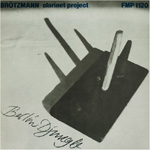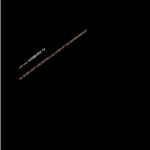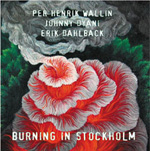| |
Unheard Music Series : Brötzmann, Dudek, Schlippenbach, Wallin
by Jay Collins
November 2004
Since 2001, Atavistic's Unheard Music Series has proven to be
a boon for European Free Music fans, especially as further out-of-print
gems trickle out of the FMP vaults. Though not every release in the
UMS series focuses on overseas talent (e.g., gems like Baby Dodds's
Folkways rarities or works from Chicagoans Fred Anderson and the late
Hal Russell), the FMP Archive Editions have provided treasure after
treasure. As for 2004's UMS batch, it contains several choice
goodies, including three additions to the FMP Archive stash, as well
as a previously unreleased live session from Swedish pianist Per Henrik
Wallin.
 First
up is Peter Brötzmann's Clarinet Project, Berlin Djungle.
For this one-off venture, recorded at the 1984 Berlin Jazz Festival,
Brötzmann collected six clarinetists from around the globe (himself,
John Zorn, Louis Sclavis, Tony Coe, Ernst-Ludwig Petrowsky, and J.D.
Parran), three brassmen (trumpeter Toshinori Kondo and trombonists
Hannes Bauer and Alan Tomlinson) and the vibrant rhythm tandem of
bassist William Parker and drummer Tony Oxley. The piece, "What A
Day", a two-part suite (chopped up due to LP time constraints), presents
a format that will delight Brötzmann's large group enthusiasts
with numerous spirited, bombastic moments mixed with prosaic, even
melodic journeys (i.e., Sclavis and Coe), though the massive sound
clusters tend to be those that stick to one's brain. First
up is Peter Brötzmann's Clarinet Project, Berlin Djungle.
For this one-off venture, recorded at the 1984 Berlin Jazz Festival,
Brötzmann collected six clarinetists from around the globe (himself,
John Zorn, Louis Sclavis, Tony Coe, Ernst-Ludwig Petrowsky, and J.D.
Parran), three brassmen (trumpeter Toshinori Kondo and trombonists
Hannes Bauer and Alan Tomlinson) and the vibrant rhythm tandem of
bassist William Parker and drummer Tony Oxley. The piece, "What A
Day", a two-part suite (chopped up due to LP time constraints), presents
a format that will delight Brötzmann's large group enthusiasts
with numerous spirited, bombastic moments mixed with prosaic, even
melodic journeys (i.e., Sclavis and Coe), though the massive sound
clusters tend to be those that stick to one's brain.
As for the framework of the composition, Brötzmann provides his
collective with spotlight time whether as soloists or among the thicket
of accompaniment. The ensemble frequently interacts with the soloists,
digging in, swirling around, and hoisting them towards requisite altitudes.
Though the liner notes do not provide a map as to who is out front,
an educated guess would indicate that the first section contains lyrical
work from Sclavis and then Coe, followed by a fierce workout from
Zorn. The second half of the piece reaches its apex due to trombonist
Hannes Bauer's blistering jaunts, which match Parker and Oxley's
mighty undulations. While the structures shift consistently, with
the clarinets flowing in and out of the spectrum, Brötzmann's
tenor takes the final stand in conjunction with the rhythmatists and
blazes ahead before the thunderous ensemble conclusion.
 Until 2002,
reedist Gerd Dudek had never released a recording under his own name.
That recording, 'Smatter, presented Dudek in an unexpectedly
relaxed 1998 London studio setting. On the UMS reissue of Open,
Dudek collaborates with bassist Buschi Niebergall and drummer Edvard
Vesala for a six-song program presented at Berlin's 1977 Free Music
Workshop. Each of the six pieces allows Dudek to display his facility
on his chosen reeds—tenor and soprano saxophones and flute. Until 2002,
reedist Gerd Dudek had never released a recording under his own name.
That recording, 'Smatter, presented Dudek in an unexpectedly
relaxed 1998 London studio setting. On the UMS reissue of Open,
Dudek collaborates with bassist Buschi Niebergall and drummer Edvard
Vesala for a six-song program presented at Berlin's 1977 Free Music
Workshop. Each of the six pieces allows Dudek to display his facility
on his chosen reeds—tenor and soprano saxophones and flute.
Touching off is his fluid soprano work on the record's opening
track, "H.S.", as the loose atmosphere essentially takes
shape thanks to Niebergall's spidery basswork and Vesala's
open-ended pulse. Likewise, the closing piece, "Chain",
presents feisty soprano flights alongside a roiling rhythmic reinforcement.
Dudek displays his spiritual aims on "Mira", where his wiry
flute tones lead to the session's highest highs, especially after
he picks up his soprano for some concluding words. The almost twelve-minute
title track, though, is the focal point for the display of Dudek's
flute technique, especially when he vocalizes through the mouthpiece.
Finally, Dudek's most biting lines emerge during the tenor sax
excursions of "Kugel" and "Manchmal". His harmonically
rich and edgy style fits in particularly well as the rhythm section
stokes the fires. Overall, a strong summit meeting that provides further
evidence of Dudek's improvisational strengths and why his name
appears on so many important European Free Music releases.
 Improvising
big bands are far too few in creative music and one would have to
wager that the major reason for this is due to the potential financial
suicide of running this type of collective. While many of the greatest
bands of the music do share members, arguably Alexander Von Schlippenbach's
Globe Unity Orchestra was and—thanks to a 2002 reunion—continues
to be one of the best. As for Hamburg '74, this radio project
for the NDR Jazz Workshop paired the GUO with the NDR Choir, with
Schlippenbach's goal being to contribute "to humor in music". Reedists
Peter Brötzmann, Evan Parker, Rüdiger Carl, Gerd Dudek,
and Michel Pilz, trumpeters Kenny Wheeler and Manfred Schoof, trombonists
Paul Rutherford and Günter Christmann, pianist Schlippenbach,
guitarist Derek Bailey, bassist Peter Kowald, and drummers Paul Lovens
and Han Bennink are all on board. As usual as the pairing may seem,
it is an even more remarkable listening experience, one that highlights
majesty, absurdity, bravado, and potency that never ceases to thrill. Improvising
big bands are far too few in creative music and one would have to
wager that the major reason for this is due to the potential financial
suicide of running this type of collective. While many of the greatest
bands of the music do share members, arguably Alexander Von Schlippenbach's
Globe Unity Orchestra was and—thanks to a 2002 reunion—continues
to be one of the best. As for Hamburg '74, this radio project
for the NDR Jazz Workshop paired the GUO with the NDR Choir, with
Schlippenbach's goal being to contribute "to humor in music". Reedists
Peter Brötzmann, Evan Parker, Rüdiger Carl, Gerd Dudek,
and Michel Pilz, trumpeters Kenny Wheeler and Manfred Schoof, trombonists
Paul Rutherford and Günter Christmann, pianist Schlippenbach,
guitarist Derek Bailey, bassist Peter Kowald, and drummers Paul Lovens
and Han Bennink are all on board. As usual as the pairing may seem,
it is an even more remarkable listening experience, one that highlights
majesty, absurdity, bravado, and potency that never ceases to thrill.
The first track, "Hamburg '74" is an eight-section piece, beginning
with a jocular spoken intro (auf Deutch) that melds into a
combination of the shifting voices and "an English quartet", highlighted
by a majestic Wheeler solo (and ensemble shades of "All The Things
You Are"). Following the opening sections, Christmann and Bennink
go at it, as the eerie vocalizing, including a Tibetan chant-like
section (Kowald?), leads to a frenzied duet between Dudek and Parker,
with Dudek emerging as the primary horn amidst the tussle. While a
momentous vocalized breakdown occurs midstream, the highlight of the
piece surfaces upon its remission. Subtitled "Free Jazz", this sixth
section contains two subsections, one with the Schlippenbach Quartet,
and the other a duet between Brötzmann and Bennink, where fireworks
erupt as the rest of the reeds eventually join the party. Finally,
after some conclusory a capella moments, the piece ends with
the "Special Coda" section, mixing a brilliant, operatic fanfare that
shifts to a circus-like conclusion that must be heard.
The second piece, Manfred Schoof's "Kontraste Un Synthesen"
is a different matter. The humor from the previous piece is removed
and the intensity that one normally associates with this group remains.
Beginning as a percussive dialogue, the initial abstract spaces lead
to a tightly scripted swing vibe, which is followed by a fiery exchange
between Pilz's bass clarinet and the Kowald-steered rhythm section.
The horns and voices enter with a flurry of activity, with Rutherford's
multiphonic solo providing the pivotal central point, followed by
Wheeler's (or maybe Schoof's) incisive thoughts. Before
the concluding moments, though, Kowald and Bailey joyously joust as
the piece simmers down into quieter realms.
 Swedish
pianist Per Henrik Wallin continues to be largely overlooked, perhaps
due to the fact that the majority of his legacy remains out of print.
This 1981 concert of previously unreleased material, Burning In
Stockholm, presents Wallin in performance with bassist Johnny
Dyani and drummer Erik Dahlbäck. As Mats Gustafsson's enthusiastic
liners indicate, Wallin's trio (with regular bassist Torbjörn
Hultcrantz) was an inspiration not only to Gustafsson, but other young
listeners eager to eat up the thrilling pursuits of Wallin and his
cohorts. As a pianist, Wallin consistently proves his unpredictability,
throwing out some quasi-bop lines here, adding a tinge of folk there,
or flying precipitously around his instrument with abandon and yet,
in a way connected to his co-conspirators. Worth special mention are
the contributions of Dyani, whose muscular, yet graceful movements
demonstrate both delight and technical prowess. Swedish
pianist Per Henrik Wallin continues to be largely overlooked, perhaps
due to the fact that the majority of his legacy remains out of print.
This 1981 concert of previously unreleased material, Burning In
Stockholm, presents Wallin in performance with bassist Johnny
Dyani and drummer Erik Dahlbäck. As Mats Gustafsson's enthusiastic
liners indicate, Wallin's trio (with regular bassist Torbjörn
Hultcrantz) was an inspiration not only to Gustafsson, but other young
listeners eager to eat up the thrilling pursuits of Wallin and his
cohorts. As a pianist, Wallin consistently proves his unpredictability,
throwing out some quasi-bop lines here, adding a tinge of folk there,
or flying precipitously around his instrument with abandon and yet,
in a way connected to his co-conspirators. Worth special mention are
the contributions of Dyani, whose muscular, yet graceful movements
demonstrate both delight and technical prowess.
The single, 49-minute excursion is a testament to the trio's
stamina. Commencing with a rolling, elastic groove at the outset,
the music ebbs and flows in accordance with Wallin's desires.
For instance, after the opening quarter of music, at the fourteen-minute
mark, the trio locks into a funky, barrelhouse theme that returns
intermittently during the remaining 30 minutes. What originally commences
as a rather inside path resolves into a flurry of hyperkinetic runs
at the halfway point, a showpiece for the trio's versatility.
While the concert is certainly challenging, it also contains bursts
of showmanship and humor. Take, for instance, the ode to America,
seen through a nod to Bernstein's "America" at the
28-minute mark and later, hints of "The Star Spangled Banner".
Further, the trio also hints at other folk themes, sprung out of the
sparkling interplay between these attuned souls. Just as Gustafsson
promises, this trio represents the utmost in communication for music
that frightens, puzzles, and burns.
|
|
|
|
|

